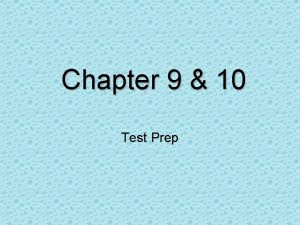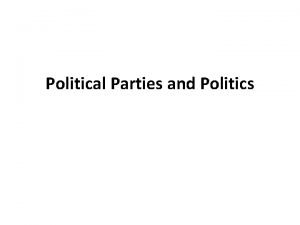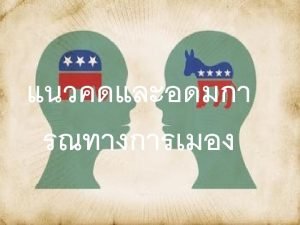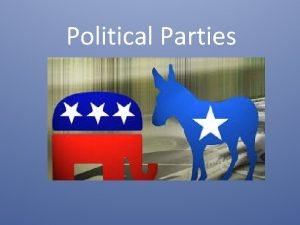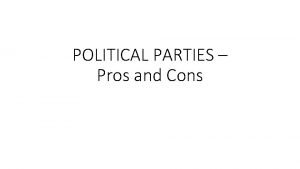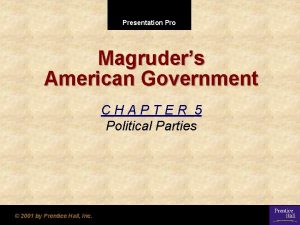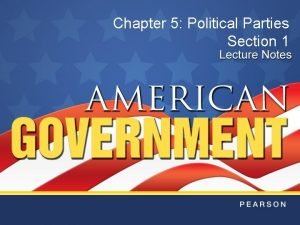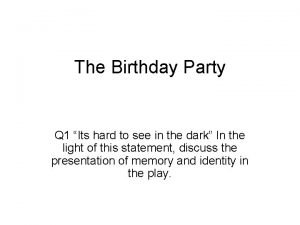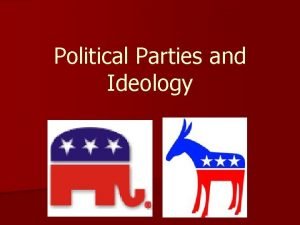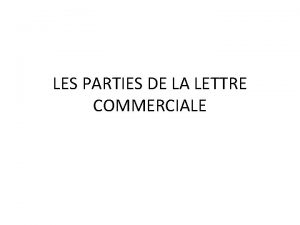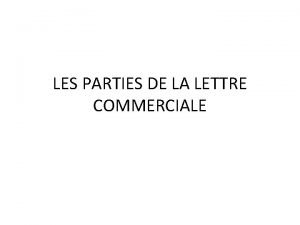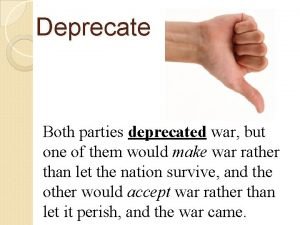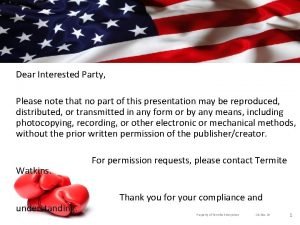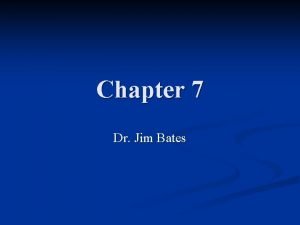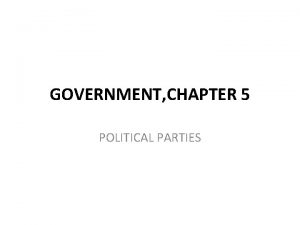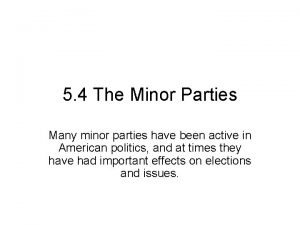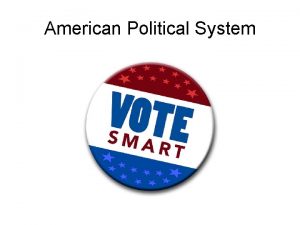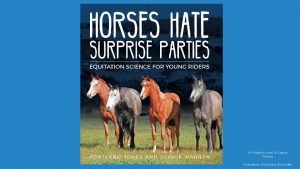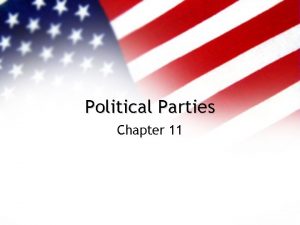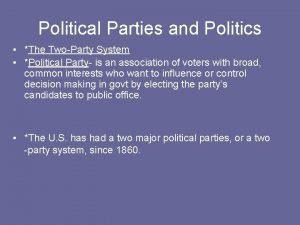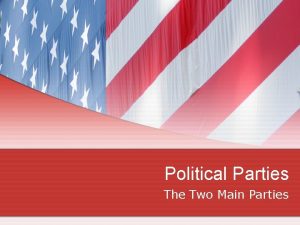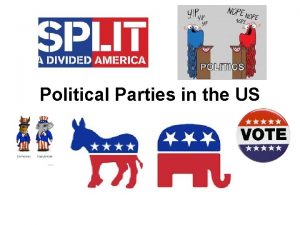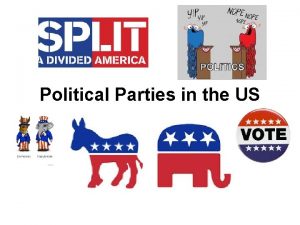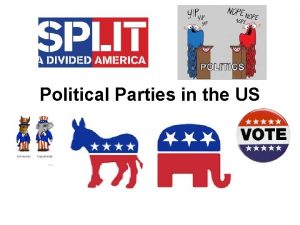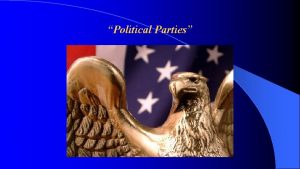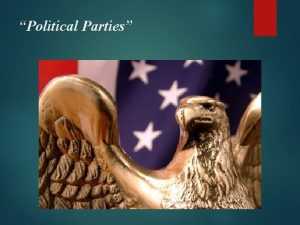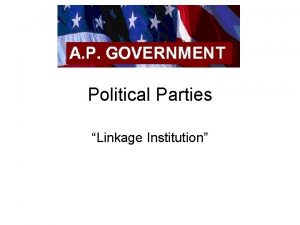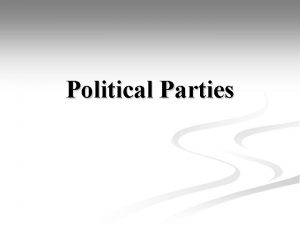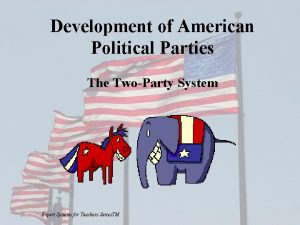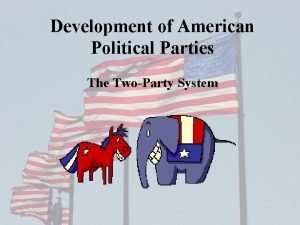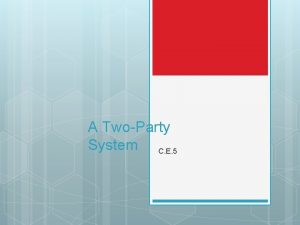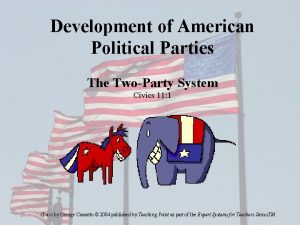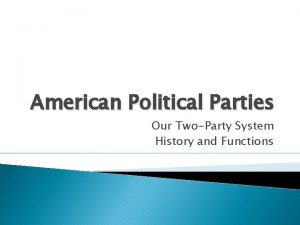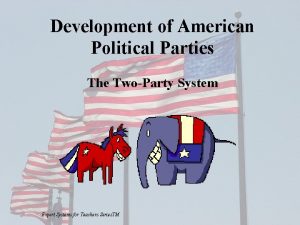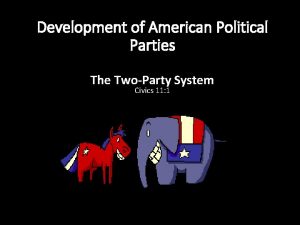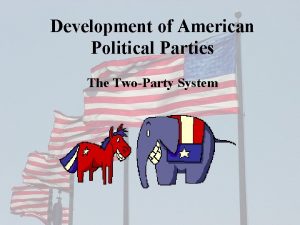Chapter 5 Political Parties The TwoParty System A

































- Slides: 33

Chapter 5 Political Parties

The Two-Party System “A party of order or stability, and a party of progress or reform, are both necessary elements of a healthy state of political life. ” ~ John Stuart Mill

Two-Party System (Major) Party- a group of persons who seek to control government through the winning of elections and the holding of public office(s). ◦ Republicans ◦ Democrats (Minor) Party- one of the many political parties without wide voter support. ◦ Green Party ◦ Prohibition Party

Two-Party System Where in a typical political election, two major parties dominate American politics. A number of factors explain why America has had and continues to have a two-party system.

The Historical Basis Framers of the Constitution were opposed to political parties. ◦ Federalist No. 10: One can either destroy the factions, or somehow, control its outcomes. ◦ Bi-partisan system still follows Madison’s “multiple” faction government. ◦ Federalist No. 14: “Big Tent” involves inviting multiple factions/spheres of thought into the Big Tent ◦ A means of controlling the “mob mentality”

The Force of Tradition Started with the Federalists and Anti. Federalist ◦ More Americans except the idea of a two-party system because there has always been one ◦ James Madison said that a larger Republic is better, as to increase the number of factions, and to distribute power No one party can overpower the system… or can they?

The Electoral System Single-member districts: Electoral process in which one person is chosen by the voters for each elected office Plurality: The winning candidate who receives a the largest number of votes cast for an office ◦ The plurality does NOT have to be the majority Bipartisan: The two major political parties find common ground and work Together

The American Ideological Consensus The American people over time have shared many of the same ideals, same basic principles, and same patterns of belief Pluralistic Society: One consisting of several distinct cultures and groups ◦ The United States is the “melting pot” of the world Federalist Paper No. 55 ◦ Argues that a smaller assembly is better for the country. More likely to get things RATIFIED ◦ However, this is contradictory to the People’s Voice

American Ideological Consensus: A general agreement ◦ 1. 2. 3. 4. 5. Not always so in American society American Civil War Great Depression Vietnam Era Persian Gulf War II (Afghanistan and Iraq) Party Polarity (Republicans v. Democrats)

Third Party?

Multiparty Systems A system in which several major and many lesser parties exist, seriously compete for, and actually win public office(s). Based around particular interests, including: ◦ ◦ Economic class Religious beliefs Sectional attachment Political ideology Creates a broader and more diverse representation of electorates.

One-party Systems A political system in which only one party exists. Falls under a dictatorship in many nations. Within the United States, a modified oneparty system is prevalent in certain regions of the country. Post Civil War Elections: ◦ Republican party = New England & Midwest ◦ Democrats = South

The Two-Party System in America Federalist No. 10 & 51 Both majority and minority factions are brought up, and Madison believes that the majority factions are the most dangerous. Using the liberties of citizens can bring down a Democracy. Factions- conflicting groups

First Political Parties Election of 1800 ◦ “The Great Revolution” signified the transfer of political powers from one political party to another ◦ The incumbent Federalist president, John Adams, was defeated by Republican Thomas Jefferson Incumbent- current office holder Since then, there have been 4 major periods of political party dominance.

American Parties Era of the Democrats (1800 -1860) Although called Republicans, the Democratic. Republicans can be compared to the Democratic Party of today. Ran unopposed in national politics up to 1830. ◦ Split up into factions with the introduction of the Andrew Jackson administration ◦ National Republicans (Whigs) vs. Democrats

American Parties Era of the Republicans (1860 -1932) Republican dominance started in 1860 with the election of President Lincoln. Only political party to jump from 3 rd party to major party status Electorate- the people eligible to vote. Sectionalism- the devotion toward interests of one section of the country or population

American Parties The New Democratic Era (1932 -1968) The Great Depression brought the election of a new American leader, FDR Democrats held the national government up to the Vietnam War ◦ Richard Nixon’s second attempt for the presidency proved successful for a short-term Republican reign

American Parties Era of Division (1968 -current) New points of interest have created a rift between the public’s concern and that of the political parties’ agendas

The Minor Parties Ron Paul Ralph Nader

Minority Parties in the U. S. There are MANY neglected third parties that field a presidential candidate ◦ ◦ ◦ ◦ ◦ Constitution Party Green Party of the U. S. Communist Party Libertarian Party America First Party Freedom Socialist Party Reform Party Prohibition Party American Nazi Party And Many More…

4 Types of Minor Parties 1. Ideological Parties based on a particular set of beliefs-a comprehensive view of social, economic, and political matters. ◦ Have seldom been able to win many votes ◦ Libertarian Party- focuses on the individual ◦ Communist Party- focuses on the well-being of the society

4 Types of Minor Parties 2. Single-Issue Parties that focus on only one public-policy matter ◦ Most of these parties fade into history, with the issue they stood for. ◦ The two major parties may address their key issue, as one of their own. ◦ Usually found in the minor party name. Prohibition Party (Founded 1869) U. S. Marijuana Party (Founded 2002)

4 Types of Minor Parties 3. Economic Protest Parties rooted in periods of economic discontent. ◦ There is no clear-cut ideological base ◦ A disgust toward the two major parties Occupy Wall Street ◦ Most often, they have been sectional parties Drawing strength from the South & West ◦ Greenback Party (1876 -1884) ◦ Populist Party (1890 s)

4 Types of Minor Parties 4. Splinter Parties that have split away from one of the major political parties ◦ Most of the more important 3 rd parties have been splinter parties ◦ Form around a strong personality-an individual ◦ These parties usually collapse when the individual steps down Bull Moose Progressive Party (1912) Green Party with Ralph Nader

Why Minority Parties are Important Third-party candidacy can act as a “spoiler role” in a close election. ◦ Theodore Roosevelt’s Bull Moose Party took away votes from the Republican candidate in the 1912 election Minor parties act as the critics (bring attention to wrong doing) and innovators (new ideas are co-opted by major parties) for political issues

Effects of Third Party http: //www. youtube. com/watch? v=2 dd 2 OAgn 8 Q&feature=related

Party Organization

National Party Machinery Each major American political party builds its structure from four basic elements: 1. The National Convention 2. The National Committee 3. The National Chairperson 4. The Congressional Campaign

State & Local Party Machinery State party foundations are set by State law: 1. State Organization- chairperson and the State Central Committee 2. Local Organization- follow the electoral map of a State ◦ ◦ ◦ Ward: a unit into which cities are often divided for the election of city council members Precinct: the smallest unit of election administration Polling Place: voting locations within the precinct

Roles of the Major Parties 1. 2. 3. 4. 5. Nominating Candidates Informing & Activating Supporters: shared with news media & interest groups Bonding Agent: tries to pick qualified candidates with good moral character Watch Dog: party out of power watches party in power (holds the White House) Governing: office holders, executive appointments, etc…basis for conducting government, provides channels for the Exec/Leg branches to work together

Reasons for Party Decline *Sharp drop in number of voters who classify themselves as Republican or Democrat Rise in Independents/Minor Parties *Split-Ticket Voting: voting for candidates of different parties for different offices at the same election A true system with bipartisan behaviors – issue voting *Straight – ticket Voting: voting for all the candidates in one party * Coattail Effect: Strong candidate helps to attract voters to other lesser candidates in the same party

Voter Qualifications: Qualifications set by the States (5 limitations by Constitution): * Sufferage: the right to vote 15 th Amendment: removed race/color 19 th Amendment: removed sex/gender 23 rd Amendment: DC right to vote 24 th Amendment: eliminated poll taxes 26 th Amendment: 18 yr olds can vote Voting Rights Act of 1965: removed literacy tests, gave Federal government more power to enforce 15 th amendment being ignored by the states National Voter Registration Act 1993 (Motor Voter Act): Allowed people to register to vote by mail, @ time of license renewal/application, with registration forms found in public assistance offices

OPEN PRIMARY: any qualified voter may vote CLOSED PRIMARY: only declared party members may vote CAUCUS/ CONVENTION: groups of like-minded people who meet to sect candidates for election GENERAL ELECTION: all or most memebers of a given political body are up for election SPECIAL INTEREST GROUPS: private organizations trying to persuade public officials to respond to the shared attitudes of its members – to shape public policy PAC’s: Political Action Committes – political arms of special interest groups, lobbyists HARD MONEY: $$ contributed directly to the candidate, subject to regulation ($2400 ind/ $5000 org) SOFT MONEY: $$ contributed to the political party by large donors, unregulated
 What was one way progressives differed from populists
What was one way progressives differed from populists Win the white house brainpop
Win the white house brainpop Political parties
Political parties Political parties
Political parties Political party
Political party Wikimedia
Wikimedia Political parties
Political parties Political parties pros and cons
Political parties pros and cons Economic protest parties definition
Economic protest parties definition Chapter 5 section 1 parties and what they do
Chapter 5 section 1 parties and what they do Chapter 5 section 1 parties and what they do
Chapter 5 section 1 parties and what they do Essay on birthday party in 200 words
Essay on birthday party in 200 words Self-announcement definition
Self-announcement definition Foods party
Foods party Les parties de la lettre commerciale
Les parties de la lettre commerciale La lettre commerciale
La lettre commerciale Race de dauphin
Race de dauphin Major changes in iso 9001 for 2015
Major changes in iso 9001 for 2015 Deprecate in a sentence
Deprecate in a sentence Dear interested parties
Dear interested parties Francesco redi
Francesco redi Why does george wilson lock myrtle in the bedroom?
Why does george wilson lock myrtle in the bedroom? The smallest unit of election administration
The smallest unit of election administration Sarah and pam often go to parties
Sarah and pam often go to parties Les parties du texte narratif
Les parties du texte narratif Interactions between ais and internal and external parties
Interactions between ais and internal and external parties Single issue parties definition
Single issue parties definition Socialist parties
Socialist parties Texte argumentatif sec 5
Texte argumentatif sec 5 Proc cochleariformis
Proc cochleariformis Comparaison entre cellule animale et végétale
Comparaison entre cellule animale et végétale Why did gatsby throw parties
Why did gatsby throw parties Power point parties
Power point parties Barbara hinchcliffe
Barbara hinchcliffe
